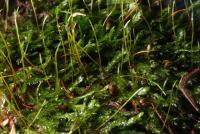
Consortium of Bryophyte Herbaria
- building a Consortium of Bryophytes and Lichens as keystones of cryptobiotic communities -
|
|
|
|
Family: Plagiotheciaceae
toothed plagiothecium moss
[Hypnum denticulatum Hedw., moreHypnum denticulatum subsp. sylvaticum (Brid.) Boulay, Hypnum denticulatum var. donnianum (Sm.) Hook., Hypnum denticulatum var. majus Boulay, Hypnum denticulatum var. obtusatum (Wahlenb.) Wahlenb., Hypnum denticulatum var. obtusifolium Turner, Hypnum denticulatum var. sylvaticum (Brid.) Turner, Hypnum donnianum Sm., Hypnum obtusatum Wahlenb., Hypnum obtusifolium (Turner) Brid., Hypnum sylvaticum Brid., Pancovia denticulata (Hedw.) J. Kickx f., Pilaisaea radicans Bach. Pyl., Plagiothecium auritum (Kern) Jedl., Plagiothecium denticulatum subsp. donnianum (Sm.) Giacom., Plagiothecium denticulatum subsp. sylvaticum (Brid.) Dixon, Plagiothecium denticulatum var. auritum Kern, Plagiothecium denticulatum var. denticulatum , Plagiothecium denticulatum var. donii Lindb., Plagiothecium denticulatum var. donnianum (Sm.) Lindb. ex Weim., Plagiothecium denticulatum var. majus (Boul.) Delogne, Plagiothecium denticulatum var. obtusatum (Wahlenb.) Hartm., Plagiothecium denticulatum var. obtusifolium (Turn.) Moore, Plagiothecium denticulatum var. podperae Jedl., Plagiothecium donnianum (Sm.) Mitt., Plagiothecium kinlayanum Stirt., Plagiothecium majus (Boulay) Jedl., Plagiothecium obtusifolium (Turner) J.J. Amann, Plagiothecium orthothecioides (Meyl.) Jedl., Plagiothecium podperae (Jedl.) Jedl., Plagiothecium pseudosylvaticum Warnst., Plagiothecium rufovirescens Stirt., Plagiothecium ruthei f. orthothecioides (Meyl.) Jedl., Plagiothecium ruthei var. orthothecioides Meyl., Plagiothecium ruthei var. pseudosilvaticum (Warnst.) Warnst., Plagiothecium sandbergii Renauld & Cardot, Plagiothecium stoloniferum Velen., Plagiothecium subdenticulatum Correns, Plagiothecium sylvaticum (Brid.) Schimp., Plagiothecium trichodeum Stirt., Stereodon denticulatus (Hedw.) Brid., Stereodon denticulatus var. obtusifolius (Turner) Brid., Stereodon donnianus (Sm.) Mitt., Stereodon sylvaticus (Brid.) Brid.] |
Plants: in thin to dense mats, dark green to yellowish, dull or glossy. Stems: to 5 cm, 1–4 mm wide across leafy stem, prostrate or rarely erect, complanate-foliate or sometimes julaceous. Leaves: somewhat spreading, rarely secund with apices pointing toward substratum, imbricate, oblong-ovate or ovate-lanceolate, asymmetric, flat to concave, 1.5–4 × 0.5–2 mm; margins broadly recurved nearly to apex or sometimes plane, serrulate at extreme apex or rarely entire; apex acute to acuminate or rarely narrowly obtuse, not abruptly contracted, seldom recurved; costa with one branch sometimes reaching mid leaf or rarely ecostate; alar cells spheric, oval, quadrate, or rectangular, 19–80 × 19–29 µm, in 3–8 vertical rows, terminating in several spheric or oval cells at base, region often auriculate and oval, sometimes cells quadrate and rectangular, terminating in 1 cell at base, region triangular; medial laminal cells 70–180 × 12–21 µm. : Specialized asexual reproduction often present as propagula, 72–178 × 9–24 µm, of 3–7 cells borne in leaf axils. Sexual: condition autoicous or sometimes dioicous, usually fruiting. Seta: light brown to red, 1.5–3.5 cm, curved. Capsule: cernuous or rarely erect or inclined, light brown to orange-brown when mature, arcuate, rarely straight when erect or inclined, 1.5–3.5 × 0.5–1 mm, striate or sometimes wrinkled, rarely smooth, strongly wrinkled at neck; operculum short-rostrate, 0.7–1 mm; endostome cilia 2 or 3. Spores: 9–13 µm. Phenology: Capsules mature summer. Woodlands on rotten logs, stumps, base of trees, humus or soil overlying boulders and cliffs. low to high elevations (50-2700 m). Greenland, Alta., B.C., Man., N.B., Nfld. and Labr., N.W.T., N.S., Nunavut, Ont., P.E.I., Que., Sask., Yukon, Alaska, Ariz., Calif., Colo., Conn., Del., D.C., Idaho, Ill., Ind., Iowa, Maine, Md., Mass., Mich., Minn., Mo., Mont., Nev., N.H., N.J., N.Mex., N.Y., N.C., Ohio, Oreg., Pa., R.I., Tenn., Utah, Vt., Va., Wash., W.Va., Wis., Wyo., Europe, Asia, Africa. Plagiothecium denticulatum is one of the most common and variable species of the genus in the flora area. Sometimes (especially in western North America) the stems are julaceous, to 3 cm, the leaves are strongly concave, nearly symmetric, narrowly obtuse, 1.5–2 mm, and the capsules are almost straight and erect. The leaves have some apices pointing toward the substratum, as is also the case in P. laetum. Plagiothecium denticulatum has been reported for Australia and New Zealand, but an examination of the specimens from those regions revealed that they are P. novae-seelandiae Brotherus (R. R. Ireland 1992). |
|
|
|
Powered by Symbiota.



































































































